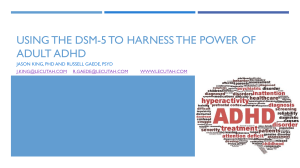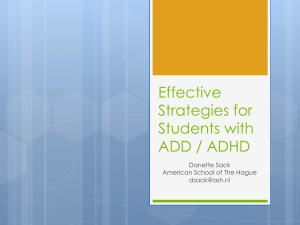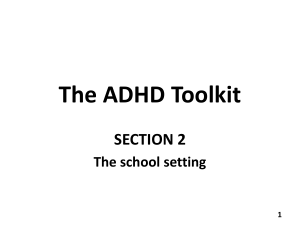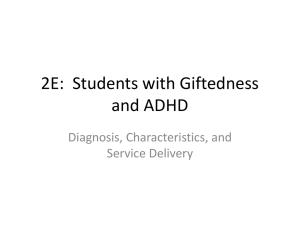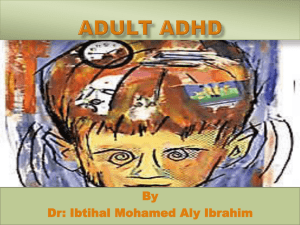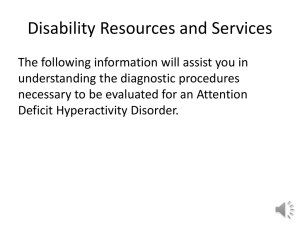The Neurotoxicology of attention deficits
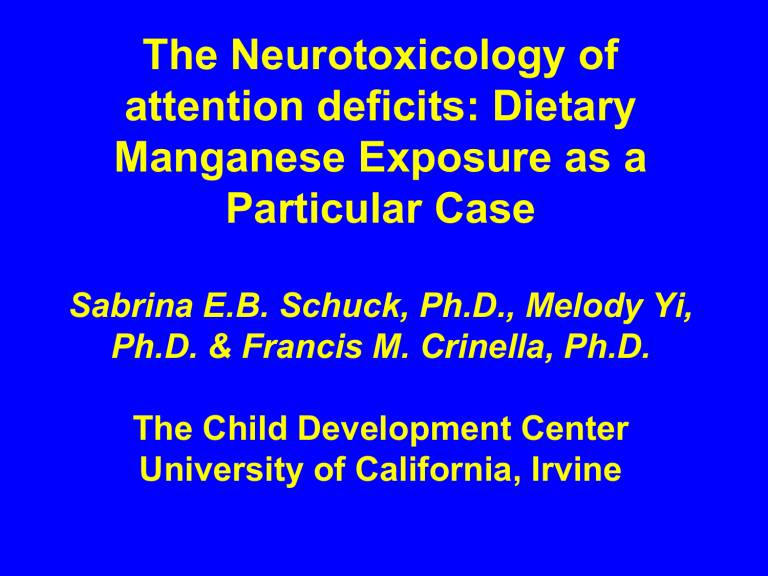
The Neurotoxicology of attention deficits: Dietary
Manganese Exposure as a
Particular Case
Sabrina E.B. Schuck, Ph.D., Melody Yi,
Ph.D. & Francis M. Crinella, Ph.D.
The Child Development Center
University of California, Irvine
Everyone knows what attention is.
It is the taking possession in the mind, in clear and vivid form, of one out of what seem several simultaneous object or trains of thought.
William James [The Principles of
Psychology, 1890]
ATTENTION HELPS US TO MANAGE
CONFLICTING PERCEPTUAL INPUTS
ATTENTION ALLOWS US TO
PERSIST IN TASK PERFORMANCE
ATTENTION HELPS US FOCUS ON
THE TASK AT HAND
ATTENTION ENABLES US TO PERFORM
TASKS THAT REQUIRE PLANNING AND
WORKING MEMORY
ATTENTION ENABLES US TO MAINTAIN
VIGILANCE WHEN MONITORING SIGNALS
ATTENTION ENABLES US TO AVOID
COSTLY ERRORS
HOWEVER: ATTENTION IS THE MOST
FRAGILE OF ALL MENTAL FUNCTIONS
1. ATTENTION CAN BE ADVERSELY AFFECTED BY ANY
NUMBER OF INTERNAL AND EXTERNAL INFLUENCES
2. ALL NEURODEVELOPMENTAL AND
NEUROPSYCHIATRIC DISORDERS ARE ACCOMPANIED
BY ATTENTION DEFICITS
3. ADHD IS BUT ONE OF MANY DIAGNOSABLE
CONDITIONS IN WHICH ATTENTION IS AFFECTED
DSM-IV SYMPTOMS OF ADHD
INATTENTION
• CAN’T ATTEND TO DETAILS
• CAN’T SUSTAIN ATTENTION
• DOESN’T LISTEN
•
FAILS TO FINISH
• CAN’T ORGANIZE TASKS
• AVOIDS SCHOOLWORK
• LOSES THINGS
•
EASILY DISTRACTED
•
FORGETFUL
HYPERACTIVITY/IMPULSIVITY
• FIDGETS
• CAN’T STAY SEATED
•
RUN ABOUT AND CLIMBS
• CAN’T PLAY QUIETLY
• IS OFTEN ON THE GO
• TALKS TOO MUCH
•
BLURTS OUT ANSWERS
• CAN’T WAIT TURN
•
INTERRUPTS OR INTRUDES
BIOLOGICAL BASIS OF
ADHD
I. PSYCHOPHARMACOLOGY
II. MOLECULAR BIOLOGY
III.BRAIN IMAGING
IV.ELECTROPHYSIOLOGY
V. NEUROPSYCHOLOGY
I. PSYCHOPHARMACOLOGY
TREATMENT WITH CNS STIMULANTS
BENZEDRINE (Bradley, 1937)
DEXTROAMPHETAMINES (e.g., Dexedrine, Adderall)
METHYLPHENIDATES (e.g., Ritalin, Concerta)
THE DOPAMINE HYPOTHESIS
Wender P. Minimal brain dysfunction in children. Wiley-Liss, New York (1971).
Levy F. The dopamine theory of attention deficit hyperactivity disorder (ADHD).
Aust. N. Z. J. Psychiatry 25, 277-83 (1991).
Grady D, Moyzis R, Swanson JM. Molecular genetics and attention in ADHD. Clin.
Neurosci. Res. 5, 265-272 (2005).
BIOLOGICAL BASIS OF ADHD II:
MOLECULAR BIOLOGY
• DOPAMINE D4 RECEPTOR GENE POLYMORPHISM
ASSOCIATED WITH ADHD (Lahoste, Swanson et al., 1996,
Molecular Psychiatry)
• ASSOCIATION OF THE DOPAMINE RECEPTOR D4 (DRD4)
GENE WITH A REFINED PHENOTYPE OF ADHD (Swanson,
Sunohara, Kennedy et al., 1998, Molecular Psychiatry)
• MOLECULAR GENETICS AND ATTENTION IN ADHD (Grady,
Moyzis & Swanson, 2005, Clinical Neuroscience Research)
From Grady, Moyzis & Swanson, (2005), Clinical Neuroscience Research , 5, 265-272
From Grady, Moyzis & Swanson (2005), Clinical Neuroscience Research , 5, 265-272.
BIOLOGICAL BASIS OF
ADHD III: STRUCTURAL
IMAGING
LONGITUDINAL MAPPING OF CORTICAL
THICKNESS AND CLINICAL OUTCOME IN
CHILDREN AND ADOLESCENTS WITH
ATTENTION-DEFICIT/HYPERACTIVITY
DISORDER. Shaw, Lerch, Greenstein et al. (2006),
Archives of Genetic Psychiatry, 63, 540-549.
IV. ELECTROPHYSIOLOGY
Early studies of analog EEG:
Satterfield, J.H., & Schell, A.M. (1984). Childhood brain function differences in delinquent and non-delinquent hyperactive boys. Electroencephalography and Clinical
Neurophysiology, 57, 199-207.
Finding: Abnormal maturational effects of auditory eventrelated potential differentiated ADHD from non-ADHD subjects
Recent brain mapping studies:
Pliszka, S.R., Liotti, M., & Woldorff, M.G. (2000). Inhibitory control in children with attention-deficit/hyperactivity disorder. Biological Psychiatry, 48,238-46.
Finding: Event related potentials identify the processing component and timing of an impaired right-frontal responseinhibition mechanism.
V: NEUROPSYCHOLOGICAL
EVIDENCE
• ADHD conceptualized as “frontal lobe” disorder
(e.g., Douglas, 1980; Chelune et al., 1986)
• ADHD conceptualized as disorder of “executive function” (Pennington et al., 1990; Barkley 1997;
Schuck & Crinella, 2000)
Brief Definitions of Executive
Function
• Appropriate set maintenance to achieve a future goal (Pennington, Welsh & Grossier, 1990)
• A process that alters the probability of subsequent responses to an event, thereby altering the probability of later consequences
(Barkley, 1997).
• A process which enables the brain to function as many machines in one, setting and resetting itself dozens of times in the course of a day, now for one type of operation, now for another (Sperry,
1955)
EXECUTIVE FUNCTIONS CAN BE
ADVERSELY AFFECTED BY ANY
NUMBER OF NEUROTOXINS
FOR EXAMPLE:
• PESTICIDES
• LEAD (Pb)
• CNS STIMULANTS
Odds Ratio of Detectable Pesticide in Serum
Children 8-12 Years Old (n = 167)
Oahu vs. Neighbor Islands
5
3.8
4
3
2
1
1.7
1.0
1.4
0
Heptachlor
Epoxide pp'-DDE Oxychlordane trans-Nonachlor
From Baker, Yang & Crinella, 2004, Neurotoxicology , 25, 700-701
STANDARD SCORES ON NEUROBEHAVIORAL TESTS
FOR SUBJECTS BORN ON OAHU (n = 332) vs.
SUBJECTS BORN ELSEWHERE (n = 112)
140
120
100
80
60
40
20
0
RAVEN WRAML HRTMT STROOP WCST
BORN ELSEWHERE
OAHU BORN
CPT HIT REACTION TIMES FOR CHILDREN (AGES 7
—10),
STIMULANT-EXPOSED IN UTERO AND AGE-MATCHED CONTROLS
BY ISI INTERVALS
650
600
550
500
450
400
350
300
800
750
700
1 2
1 SEC
3 4 5 6 7
2 SEC 4 SEC
8 9 10 11 12 13 14 15 16 17 18 19 20
BLOCKS OF TRIALS
---------STIMULANT EXPOSED
----------CONTROLS
12
HYPERACTIVITY RATINGS AS A FUNCTION OF Pb LEVELS IN
TIJUANA CHILDREN
10
8
6
4
2
0
< 5 5--8 9--12 13--16
Pb LEVELS IN µG/DL
17--22 >22
STUDIES ASSOCIATING HAIR
MANGANESE [Mn] LEVELS WITH ADHD
Pihl, R.O. & Parks, M. (1977). Hair element content in learning disabled children. Science, 198, 204-206.
Collip, P.J., Chen, S.Y. & Maitinsky, S. (1983). Manganese in infant formulas and learning disability. Annals of Nutrition and
Metabolism, 27, 488-494.
Marlowe, M. & Bliss, L. (1993). Hair element concentrations and young children's behavior at school and home. Journal of
Orthomolecular Medicine, 9, 1-12.
Cordova, E.J., Ericson, J., Swanson, J.M., & Crinella, F.M. (1997).
Head hair manganese as a biomarker for ADHD. Proceedings of the 15 th Annual Conference on Neurotoxicology.
HEAD HAIR Mn LEVEL
0.14
0.12
0.1
0.08
0.06
0.04
0.02
0
ADHD CONTROL
PPM
IS MN EXPOSURE AN ETIOLOGIC
AGENT IN ADHD?
1. CHILDREN WITH ADHD HAVE HIGH LEVELS OF
HEAD HAIR MN
2. MN IS A KNOWN NEUROTOXIN
3. MN TOXICITY AFFECTS BRAIN DOPAMINE
SYSTEMS
4. ADHD IS A PRIMARILY DOPAMINERGIC DISORDER
Critical Observations Regarding
Mn in infants and children
Manganese in head hair of children with ADHD may be the result of soy-based infant formulas
(Collip et al., 1983)
Term infants fed soy formula have significantly higher blood Mn than breast-fed infants
(Kirchgessner et al., 1981)
High, positive retention of Mn from formula, but not breast milk in preterm infants (Lonnerdal,
1994)
INFANT DIETARY MN INTAKE
HYPOTHESES
Since Mn is well absorbed from infant diets, and absorbed Mn is retained by the body, it will accumulate in brain, resulting in:
1. Depleted striatal DA
2. Neuromotor delay
3. Executive function deficits
Tissue Mn Assays an
Control (0)
50 µg Mn/d
250 µg Mn/d
500 µg Mn/d d1 d6 d10 d14 d20 d35 d58 d60
Righting
(d6)
Other measurements
Hb and Wt
Homing
(d10)
Passive Avoidance
(d35)
Digging latency running time (d58)
Passive Avoidance
(60-64)
2
1
0
4
3
Concentrations of Mn in brain of rats killed at day 14, 21 and 35
Brain
0
250
500 d14 d21 d35
Striatal Dopamine in Animals
Killed at d35
30
20
10
*
*
0
0 50 250 500
Mn dose (ug/day)
*Significant difference between control and low Mn exposure
PASSIVE AVOIDANCE TEST
Results of Passive Avoidance Test at d32
7.5
5.0
2.5
0.0
control 50 ug 250 ug
Mn (ug/day)
500 ug
Results of Burrowing Detour Test d55
Digging Latency
500
400
300
200
100
0
Control 50 250
Mn (
g/day)
500
0.4
0.2
0
1
0.8
0.6
2
1.8
1.6
1.4
1.2
STRIATAL DOPAMINE LEVELS AT d65
0 50 250
TREATMENT LEVEL (ug/l)
500
NONHUMAN PRIMATE MODELS
ADVANTAGES OVER RODENT MODEL
– Maturity of brain development at birth
– Prolonged period of postnatal brain development
– Complexity of behavioral repertoire
– Assessments similar to humans
Study Design
• Subjects: Male newborn rhesus monkeys
• Treatment: Exclusively formula fed freom 0-4 months of age
• Groups (n = 8):
Cow’s milk based infant formula, 0.03 µg
Mn /ml
Soy based infant formula, 0.3 µg Mn/ml
Soy + Mn; soy based infant formula with added manganese, 1 µg Mn/ml
Behavior testing schedule
APOMORPHINE
DRUG
CHALLENGE
FORMULA FEEDING
IMPULSIVITY TESTS:
NON-MATCH TO SAMPLE
POSITION REVERSAL
CPT
DIURNAL ACTIVITY
MOTOR MATURATIO N
1 2 3 4 5 6 7 8 9 10 11 12 13 14 15 16 17 18
14
12
10
8
6
4
2
0
Walk
5
4
20
18
16
14
12
10
8
6
4
2
0
3
2
1
0
Climb
Manual
Gross Motor Maturation
20
18
16
14
12
10
8
6
4
2
0
30
25
20
15
10
5
0
10
8
6
4
2
0
1 2 3 4 5 6 7 8 9 10 11 12
Session
Control
Soy
Soy + Mn
14
12
10
8
6
4
2
0
120
100
80
60
40
20
0
Amount of activity
WAKE
SLEEP
*.01
4 months 8 months
Cow’s milk
Soy
Soy + Mn
One-way mirror
Sliding test board
WGTA
Door on pulley
Delayed nonmatch to sample
Test board 1
Test board 2
.12
.1
.08
.06
.04
.02
0
Balks-no sample choice made
.
.
.
.
.
Cow’s milk
Soy
Soy + Mn
Test board
Position reversals
4
3
2
1
0
8
7
6
5 sessions to criterion for learning
6
Cow’s milk
Soy
Soy + Mn
MOTOR
IMPULSIVITY
TEST
Test board
Food reward
Sliding opaque cover
Impulsivity-response inhibition
average number of trials (of 40) on which the monkey responded at each interval
25
22.5
20
17.5
15
12.5
10
7.5
5
2.5
0
*.04
*.03
Cow’s milk
Soy
Soy + Mn
0 1-6 7 balk interval
CANTAB
Fixed interval;dopamine challenge
Continuous performance test
Dopamine drug challenge
Fixed interval responding
100
75
50
25
0
*.01
-25 0.1 mg/kg 0.2 mg/kg .0.3 mg/kg
-50 -------apomorphine-----
-75
-100 haloperidol
-125
-150 amphetamine
*.02
haloperidol+ apomorphine apomorphine, dopamine agonist, response rate haloperidol, dopamine antagonist, response rate
Cow’s milk
Soy
Soy + Mn
Social Interaction Study
• Method-videotape of dyadic interaction
• Familiar same group, unfamiliar same group, unfamiliar opposite group
• Social buffering
• Used previously to compare field cage with nursery reared males
40
35
30
25
20
15
10
5
0 dyadic interactions during round robin socialization (16 sessions)
*.003
.06
*.003
*.003
Chase play Rough play
*.03
cling
*.01
control
Soy
Soy+Mn
Age and formula effects on
CSF catecholamine metabolites
160
140
120
100
80
60
40
20
0
5HIAA control low mn hi mn
3 10 12
Months of age
HVA
300
250
200
150
100
500
450
400
350
50
0
3 10 12
Relationship between CSF catecholamine metabolites and impulsivity
45
5HIAA- 10 months of age
40
35
30
25
20
15
10
5
10 20 30 40 50 60 70 80 90 100
HVA- 10 months of age
45
40
35
30
25
20
15
10
5
150 200 250 300 350 400 450 500 550
R 2 = 0.156
R 2 = 0.19
THE “TOOTH FAIRY” STUDY
• Participants: 27 children (11 boys) from the NICHD
Study of Early Child Care and Youth Development
•
• Procedures:
– Shed molars collected from 400 children (ages 11-13); 27 teeth randomly selected
– Measures of children’s behavioral disinhibition collected from ages 3 to 9 years.
– IMS analyses of teeth performed by CAMECA IMS 1270
– Concentration of manganese in the molar cusp tip (formed at approximately the 20th gestational week) used as an indication of prenatal Mn absorption
Tooth Enamel Biomarker
• Tooth enamel layers, like tree rings, provide a temporal record of mineral absorption
• Absorbed minerals, as reflected in the tooth enamel record, may be associated with embryogenetic variations
• Depending on corresponding embryological developments in CNS, Mn absorption, as reflected in tooth enamel record, may be associated with specific variation in behavioral outcomes
Human Tooth Enamel
• As tooth develops over rime, incremental growth rings of enamel are deposited
• Oldest enamel is found at the incisal tip
• Mature enamel is a metabolic isolate
• Mn is stable in calcium hydroxyapatite
Analytical Measurements
• ion microprobe mass spectrometer (ims)
• 10 - 35 um spot resolution
• auger & sputter sample
• measurement of Mn concentration
• detection <30 ppb
• 90% accuracy
Behavior Battery
• Data base of NICHD Early Childhood
Study
• Administered Age 3, Grade 1 and Grade 3
• Teachers, mothers, and standardize tests of subjects
• 21 behavior measures (disinhibition, intelligence and depression) over 5 years
• Same subjects maintain position
RESULTS
Mn LEVELS WERE POSITIVELY CORRELATED
WITH:
Increased play with “Forbidden Toy” (36 mo.)
More impulsive errors on CPT (54 mo.)
More impulsive errors on Stroop Test (54 mo.)
Higher ratings on externalizing behavior and attentional problems (teachers and mothers; 1 st and
3 rd grades)
Higher incidence of disruptive disorders (ADHD, hyperactivity/impulsivity, and inattention (teachers, 1 st and 3 rd grades)
MULTIPLE REGRESSION ANALYSIS
(Predicting Mn Level With Behavioral Measures)
CPT (54 months)
Stroop (54 months)
CBCL Inattention (1 st grade)
DBD3 HYPERACTIVITY (3 RD GRADE)
R 2 = 0.62; df = 4, 26; P < .001
Adjustment for socioeconomic confounds did not increase significance
• Mother’s education
• Income
• Ethnicity
( F of change = .13, p = .97)
DISCUSSION
• A link was demonstrated between prenatal
Mn absorption and measures of behavioral disinhibition in later childhood
• The source of Mn was unknown, but may have been due to maternal gestational anemia, a common occurrence during pregnancy that results in overabsorption of
Mn.
CONCLUSIONS
• Attention deficits are observed in almost all neuropsychiatric disorders, including ADHD
• ADHD symptoms may are associated with a number of genetic, epigenetic and environmental influences, including toxic exposures
• Mn serves as an example of a toxic exposure that can produce ADHD-like symptoms in rodents, nonhuman primates, and humans
• The Mn-ADHD link is likely to be mediated by toxic effects on DRD4 and DAT genes.
CONCLUSIONS (CONT’D)
• The Mn-ADHD link is likely to be mediated by toxic effects on DRD4 and DAT genes.
• A DAT1 40bp VNTR 9/10 polymorphism was reliably associated with greater symptoms of
ADHD.
Barkley, Smith, Fischer & Bradford, (2006), American Journal of
Medical Genetics. 141B, 487-498.
• And, there is persistent evidence that DAT can be adversely impacted by Mn.
Kern, Stanwood & Smith, (2010), Synapse , 64, 363-378.
CONTRIBUTORS
University of California, Irvine
Aleksandra Chicz-DeMet
Louis Le
Mike Parker
Jonathon E. Ericson
K. Alison Clarke-Stewart
Virginia D. Allhusen
Tony Chan
Richard T. Robertson
University of California, Davis
Bo Lonnerdal
Mari Golub
Winyoo Chowanadisai
Stacey Germann
Casey Hogrefe
University of California, San Francisco
Trinh Tran
City University of New York
Joey Trampush

